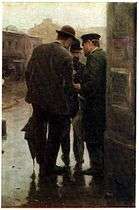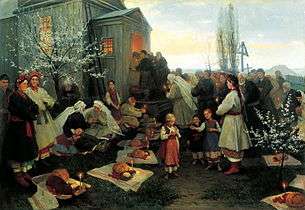Mykola Pymonenko

Mykola Kornylovych Pymonenko (Ukrainian: Микола Корнилович Пимоненко; 9 March 1862, Priorka, near Kiev - 26 March 1912, Kiev) was a Ukrainian painter; associated with the Peredvizhniki. He is best known for his urban and rural genre scenes of working-class people.
Biography
His father was a master iconographer and, after working as his assistant, he was taken to study icon painting at the Kiev Pechersk Lavra.[1] In 1876, his works were seen by Mykola Murashko, one of the founders of the Kiev Drawing School, who was impressed and lobbied the school's financial backers to allow him to study there for free.[2]
Two years later, he was able to enter the school where he worked with Murashko, Khariton Platonov and others. His examination work was sent to the Imperial Academy of Fine Arts in 1881, he received a license to teach drawing in the lower secondary schools and was able to audit classes at the Academy. He later married the daughter of one of his instructors, Volodymyr Orlovsky.[1]

In 1884, due to poor health (possibly tuberculosis) and financial difficulties, he returned to Kiev, where he found work as a drawing teacher at a private school.[3] He moved to the Kiev Polytechnic Institute in 1901, when the school went out of business, and remained there for the rest of his life. After 1906, he also taught at the new Kiev Art School, which he helped organize.[1] Kazimir Malevich was one of his most notable students.
In 1897, he participated in decorating St Volodymyr's Cathedral and was awarded the Order of Saint Anne for his work there. He became a full member of the Peredvizhniki in 1899 and was named an "Academician" in 1904.[1] He also exhibited widely; winning a gold medal at the Salon in 1909 for his painting, "Gopak". It currently hangs in the Louvre.[3]
Later, he temporarily fell out of favor with the Peredvizhniki when one of his paintings, "Going Home" was used (apparently without his permission...or disapproval) by the Shustov Vodka Company to promote their spotykach (a type of horilka). He was accused of having become "corrupted" and was forced to sue the company to have the image removed.[2]
He died in 1912 after a short, serious illness. He was buried at the Lukyanivka Cemetery, Kyiv. His posthumous exhibition at the Academy of Arts, which took place in early 1913 featured 184 paintings, 419 sketches and 112 pencil drawings. In 1959, a street was named after him and, in 1997, a museum devoted to him was opened in Malyutyanka, a village where he painted during the summers, in the Kiev-Sviatoshyn Raion. Several of his works have alternate versions, often painted years apart.
Selected paintings
 A Victim of Fanaticism
A Victim of Fanaticism A Conversation
A Conversation Easter Matins
Easter Matins Matchmakers
Matchmakers Flower Girl
Flower Girl
 Ukrainian Wedding
Ukrainian Wedding Yuletide
Yuletide
Fortune Tellers
References
- 1 2 3 4 Brief biography @ RusArtNet.
- 1 2 Biography and appreciation @ Otrok.
- 1 2 Brief biography @ Russian paintings.
Further reading
- I.V. Ogievska, Микола Пимоненко: альбом, Mystetstvo, 2013 ISBN 978-966-577-109-8
- Volodymyr Orlovsky (text), Микола Пимоненко, images compiled by Olga Zhbankova, edited by Alexander Klimchuk, Khmelnitsky Gallery, 2004 ISBN 966-8834-05-4
- Boris Chyp, O.G. Oganesyan, Микола Пимоненко: біографічний роман (biographical novel), Vol.59 of "Celebrated Names", Youth Publishing, 1983
External links
| Wikimedia Commons has media related to Mykola Pymonenko. |
- "Going Home" @ WikiArt. Note the box that may have held the product's name.
- Search results for Pymonenko @ KPI